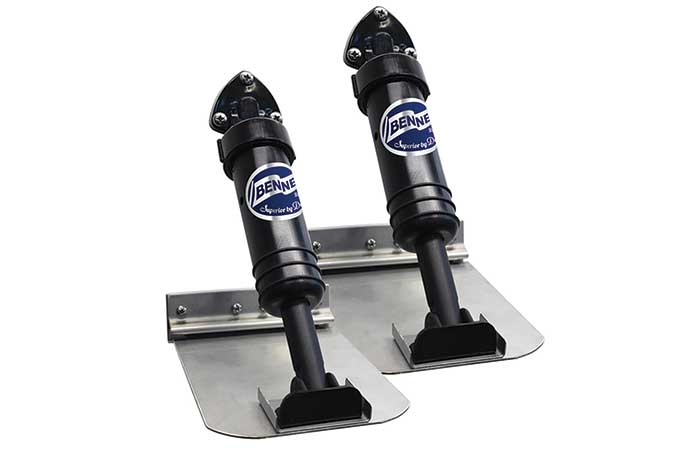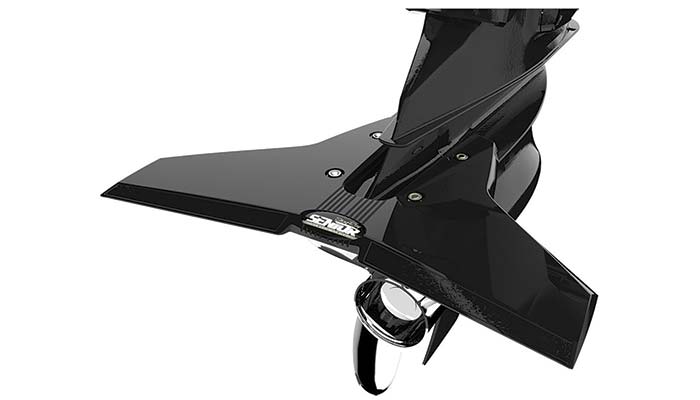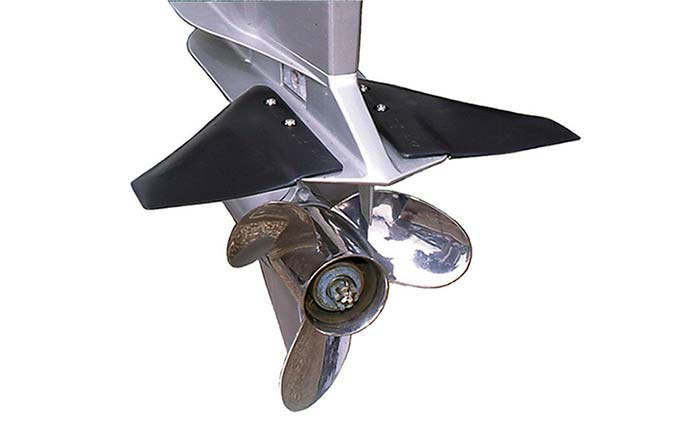Advertisement
Everyone wants to get more out of their boats. Here's a look at 4 common ways you can improve your boat control and efficiency.

Photo: Getty Images/shellexx
Everyone likes to be in control, and operating a boat is no exception. Satisfy your inner cruiser and turn your sled into a glide-ride by adding a GPS-regulated cruise control, such as the Hydrophase Ridesteady GPS speed control unit. Cooler still, how about installing a Hot Foot accelerator from T-H Marine Supplies? It's a foot pedal that easily replaces your uncool hand throttle control.

The Hydrophase Ridesteady offers GPS-regulated cruise control.
Improve that loose, worn steering by upgrading to a higher quality system and components like the SeaStar Solutions XTREME NFB (as in "no feedback") Mechanical Steering system.

SeaStar Solutions XTREME NFB
Take your steering up a notch by adding an autopilot or take complete control by adding a joystick driving system, such as the Dometic Marine Optimus 360. This steering/shift/throttle control system (designed for powerboats with mechanically controlled twin outboards) provides 360-degree maneuvering capabilities when docking, negotiating crowded areas, or loading onto your trailer.

The Optimus 360 joystick makes maneuvering easier.
Benefits: A top-notch steering system delivers better control, while having cruise control, and a Hot Foot allows you to keep both hands on the wheel and focus on steering without the distraction of working a hand throttle. Joystick control makes maneuvering into that crowded yacht club dock to catch the hot wings lunch special at the tiki bar a breeze.
While it isn't our intention to get into installation and "how it works" issues, these are worked out by the manufacturers for the different equipment. For example, the Hot Foot replaces the hand throttle cable. You install the Hot Foot pedal below the helm, then run a new throttle cable to the engine following the existing hand throttle cable route. At the engine, you disconnect the hand throttle cable and secure it out of the way. (You can remove or leave the cable and the hand throttle itself in place should you ever want to use it again.) Then you connect the cable to the engine and adjust per the directions.

The Hot Foot foot pedal gives you vehicle-like acceleration.
In any of the systems mentioned here, and others, it is critical that the operator keep a good lookout for all factors, including weather, waves, obstructions, and other boats, and remain in full and safe control and that the operator practice good seamanship skills.
Cost: A new EXTREME system runs around $250, while you can get a Hot Foot for less than $180. If you want to move sideways and do those cool 360 degree turns, entry level for the Optimus 360 starts out at around $7,000 and heads upward of $18,000 for a complete system.
More Speed
Everyone has a "need for speed" at some point, whether it's that G-force-inducing hole shot or flat-out running speed necessary to beat the competition to that prime fishing hole. Start by keeping your hull and running gear clean and free of growth, which will go a long way toward getting your glide on.
Upgrading your prop is also a relatively inexpensive way to improve your boat's speed. There are a number of characteristics that determine how a new propeller will perform when installed on a particular boat, however, primary factors to consider are construction material (aluminum verses stainless steel) diameter, pitch angle, and the number of propeller blades.
Aluminum props cost less and are also cheaper to repair or replace if damaged. If you damage an aluminum prop, you can repair or probably even replace it for less money that it takes to repair a stainless-steel prop.
Tip
Stainless steel props are more expensive but last longer. They're stronger and have less flexing, so they hold a truer pitch. This in turn equates to overall better performance and fuel economy. Stainless steel props are the better choice for saltwater and for use with higher power engines.
Benefits: A clean bottom not only increases speed but improves fuel economy. Selecting the right prop can help improve most any aspect of boat operation, from increased pickup and higher top-end speeds to increased fuel efficiency or better load-carrying performance.
Cost: For trailer boats with unpainted bottoms, maintaining a clean bottom will cost detailing supplies, time, and elbow grease. The cost of a new propeller will vary. Keep in mind, however, that while focusing on one specific characteristic may make sense in some cases, a propeller, which maximizes one desirable attribute, typically does so at the expense of others. You may want a propeller that provides good pickup out of the hole, fuel efficiency at cruising speeds, and maximum performance at top speed, but the only way to maximize each is by carrying three different props! Most boaters will have to find a happy medium, one where a prop improves the characteristic they want, but also delivers good overall performance.
More Planing Efficiency
Planing efficiency means your boat will see increased speed, comfort, and fuel efficiency.
Proper boat trim and planing efficiency go hand in hand. Achieving static (nonmoving) trim can be as simple as balancing your boat by distributing weight (e.g., passengers, coolers, portable fuel tanks) to keep the hull floating level.
Achieving stationary trim is one thing, however you'll need to make adjustments while underway to account for speed, water conditions, and direction of travel (with regard to waves and wind). Smaller boats, for example, will ride bumpier in surface chop if left trimmed at calm-water angles.


Products like the Bennett SLT self-leveling trim tabs (top) and StingRay Classic Hydrofoil Stabilizers (bottom) improve ride, speed, and fuel efficiency.
Fortunately, trim options for today's boater aren't limited to repositioning big-boned Aunt June in efforts to provide a smoother ride. Tilt and trim controls for outboards and sterndrive units provide an easy touch-of-a-button solution for making those on-the-fly adjustments.
Trim tabs (such as the Bennett SLT Self-Leveling Tabs) and products like the Doel-Fin and the StingRay Classic Hydrofoil Stabilizers are also popular aftermarket installation options to help improve planing efficiency.
Benefits: A properly trimmed boat is safer to operate and provides a more comfortable ride, better speed, and increased fuel economy. Monitor vessel trim throughout the day so you can make adjustments as the contents of fuel tanks and ice chests are used or consumed.

Doel-Fin Stabilizer Fin.
Cost: Proper stowage of gear and placement of passengers to achieve proper trim and planing cost nothing but a little planning and common sense. The SLT trim tabs cost around $130 or so (depending on model) while the Doel-Fin and StingRay Classic Hydrofoil Stabilizers can be purchased for less than $50.
More Fuel Economy
There are a number of easy ways to improve fuel economy, such as staying on top of routine engine maintenance and transferring excess weight ashore. Another easy one is modifying how you operate your boat. For example, reducing the time a planing hull displaces water prior to coming up on plane can also improve fuel economy. That's not to say you should gun the throttle to Warp 8 in order get on a plane quicker though. What we're talking here is bringing the boat up to speed at a quick yet modest, steady, safe pace.
If you want OPEC nation leaders to mutter while shaking their fists at the sky, consider installing a fuel flow meter to accurately monitor engine performance by monitoring fuel consumption. Utilizing fuel line sensors, flow meters measure fuel flow and calculate the amount of fuel consumed by your engine, providing the information in gallons per hour, total gallons consumed, or (if interfaced with a GPS unit) even nautical miles per gallon. Meters range from relatively simple analog units to complex digital display units that can combine flow meter functions with engine hours, tachometer, and display of remaining fuel and estimated range.
Once you establish a fuel consumption baseline for your boat under normal operation, conditions that can decrease fuel efficiency (such as a bent prop, fouled bottom, or clogged fuel injector) become more readily apparent. This allows you to correct problems before they worsen while saving fuel that would otherwise have been wasted prior to discovery.
Benefits: Using less fuel means spending more time on the water for less money. The fuel usage data provided by a fuel flow meter can also help find your boat's operational "sweet spot" by determining the most efficient trim, running speed, and weight distribution. Many boat owners find that simply increasing or decreasing their running speed a few hundred RPM can increase their range by as much as 20%.
Cost: Prices vary based on the installation (type of unit desired, number of engines to be monitored) and how much of a DIYer you are. Depending on the flow meter you purchase, be prepared to cut fuel lines, drill mounting holes for gauges, and run wires. Flow meters have typically used mechanical measurement tools (such as turbine or positive displacement units) in the past to monitor fuel flow. However, many newer units use ultrasonic sensors to transmit flow-rate data, greatly simplifying installation.
That said, a typical install for a twin engine boat can run upward of $1,200. While that might seem like an expensive proposition at first glance, the savings will to add up quickly — more so if it allows you to avoid even one "out of fuel" experience and the associated cost of a tow if you don't have a BoatUS towing membership.
